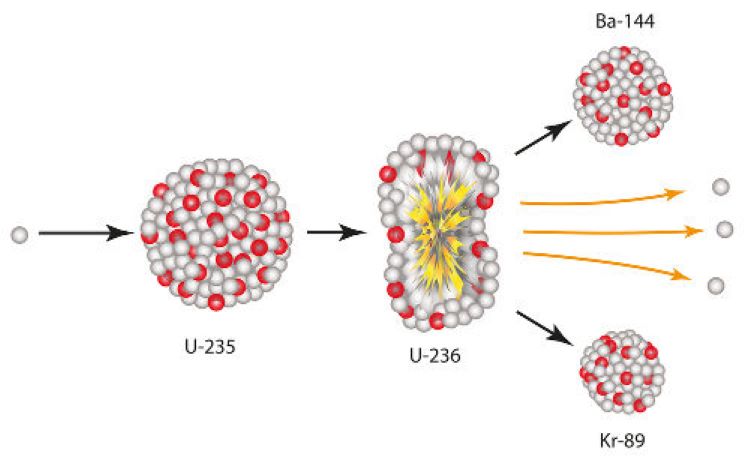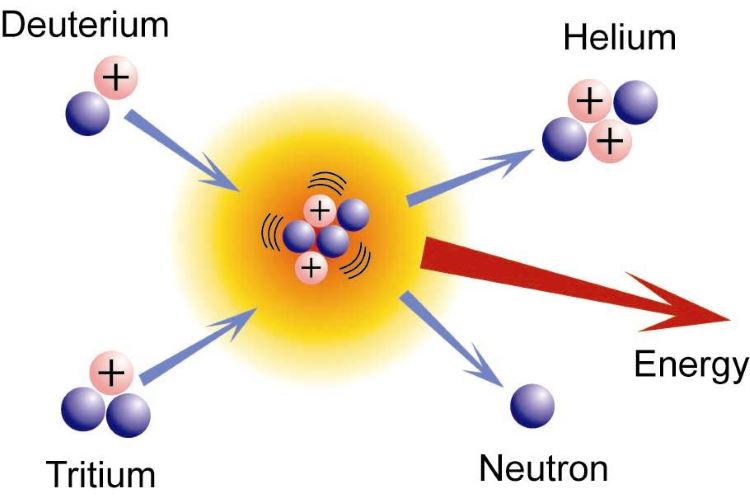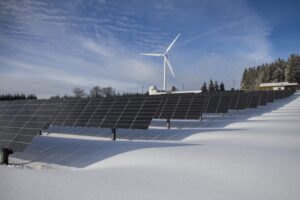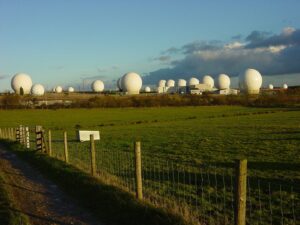The changes in the search for more sustainable and efficient energy production are the focus of major investments by different countries around the world. One of them, the laboratory Joint European Torus (JET), in the United Kingdom, had great successes in February 2022 in experiments of producing energy by nuclear fusion, which can change the world scenario in the production of clean energy in large escale.
The production of nuclear energy is already a technology used since the 50s and 60s, but the mechanism currently used on a large scale is through the fission of atoms, that is, the separation of an atom into others. Fusion is a more complicated and unstable process to be executed, but with the new discoveries there is a possibility of further growth in the use of energy via nuclear fusion in the future of society.
There are projects already under way for the construction of nuclear power plants by fusion, such as the large International Thermonuclear Experimental Reactor (ITER) in France, in consortium with more than 35 countries, as the United States, Russia and China.

What is the production of electricity via nuclear fusion
Nuclear fusion produces about 4 million times more energy than fission, since the collapse between two atoms occurs at high speed and heat; resulting in more heat, new atoms and energy.
This is the process that occurs in the main star of our system, the Sun. In it, two light hydrogen atoms at very high velocity, because of gravity, collapse with helium causing a large impact that emits a lot of energy, heat and the light that we receive on Earth.
In the star, about 600 million tons of hydrogen are fused with helium at a temperature of 15 million°C at all times, which allows the creation of the strong gravitational field that stabilizes the solar system and the movement of the planets.
To recreate this process on Earth, where gravity is not as strong as in the Sun, it is necessary to heat the hydrogen by about 100 million°C for the collision to occur, since, chemically, the heat causes the vibration of the atoms and greater the heat the greater is the movement.
The advances in energy production technology by nuclear fusion currently use two types of hydrogen: deuterium and tritium. Deuterium is found in large quantities in seawater, and tritium is extracted from lithium, a mineral. The most complicated part of the process is that both are positively charged, and just like magnets, only opposites attract.
Therefore, it is only with extremely high temperatures and energy that the movement and collision of the two is possible. After fusion, an electrically charged gas called a plasma is formed, and it is it that will heat the water and produce energy.
What is the difference between nuclear fission and nuclear fusion
Nowadays, the world already uses nuclear energy, but the reactors use fission process that is easier to obtain than fusion.
Fission is the division of the atomic nuclei, a phenomenon by which the nucleus of an atom is bombarded by a neutron (electrically neutral particles). This collision results in the creation of a totally unstable atom, which breaks up into two new elements and releases large amounts of energy, such as an explosion.
In nuclear reactors, extremely radioactive uranium-235 is normally used, that is, an unstable atom that emits a particle of its composition to achieve stability.
This is the process that occurs in atomic bombs like the ones used in Hiroshima, and this is what makes nuclear power plants so unstable that they can lead to accidents like Chernobyl.

Nuclear fusion occurs when two atomic nuclei join together, forming a new heavier and unstable element. It is a process that requires enormous amounts of energy to be sufficient to overcome the natural repulsion existing between two positively charged nuclei. However, when it happens in stars, for example, it is able to release much more energy than it consumes.

Since fission requires only the control of an element and a neutron, it is a much easier reaction to obtain with less energy. Fusion, on the other hand, requires much greater control due to the instability of the reaction between two atoms, besides requiring a higher amount of energy to occur on Earth, with a negative net energy result.
That is why, nowadays, the commercial production of nuclear energy is due to fission and not fusion, since technologies are still under development to obtain an energy profit from fusion.
However, with the advances recorded by laboratories such as JET in the United Kingdom, or the National Ignition Facility (NIF), in California, fusion technologies have a commercial energy production perspective from 2040 or 2050.
The NIF achieved the production of 1.3 MJ (Megajoules) for 1.5 MJ necessary to obtain fusion, with only the loss of 0.2 MJ in the process and getting closer to a positive net energy. JET, on 9 February 2022, achieved 59 MJ from the fusion of deuterium and tritium in 5 seconds of reaction, reaching twice the energy in less time than its own and previous world record of 1997.
What is the ITER international nuclear fusion reactor, the world’s largest nuclear fusion reactor under construction
The world’s largest nuclear fusion plant project is ITER, under development in France with investment from the International Atomic Energy Agency and support from the European Union (with the European Atomic Energy Community), China, India, South Korea, Japan and the United States.
His design was based on Soviet Tokamak technology, a device specifically designed to control the plasma at high temperature using strong magnetic fields, already used by the JET laboratory.
ITER will run from heating in 100 mi. ° C to 150 mi. ° C, for fusion of deuterium and tritium, obtaining the plasma. In order to avoid the absorption of the electric gas through the walls of the plant, the control magnets will be cooled to a temperature of -269°C and the structure will have cold water pipes that will capture the heat emitted by the reaction and generate energy.
With 500MW (Megawatts) turbines of power that will produce the energy for 7 to 20 minutes, the estimated result is 10 times more energy produced than necessary to initiate the reaction, being the largest energy production per fusion in the world.
This technology will be able to allow the production of almost unlimited clean energy, without greenhouse gases and low radioactivity, besides being safer. The result of the reaction is helium, an inert gas of nature, and it is almost impossible to cause disasters equal to the thermoelectric ones by fission, since if the reactor is stopped the reaction is weakened and undone, as it is unstable and depends on the energy supply.
The deadline for its construction is 2025, and it can start its use in ten years, in 2035. The construction at Cadarache in France caused conflicts between the six management countries and delayed the project, as there was no consensus on the site. The EU, China and Russia supported construction on French territory, but the US, South Korea and Japan wanted construction on the Japanese city of Rokkasho Mura in the north of the country.
The agreement between the countries is based on a coverage of 50% of the construction and exploration expenses by the country where the plant will reside, while the other participants will bear 10% of the cost. The project has already increased by 3 times the initial budget of US$6.6 billion, up to US$13 billion.
What other major nuclear fusion projects in the world are in the race to have a positive energy yield via nuclear fusion
Several countries and companies are moving towards achieving the greatest advance of energy production technologies and procedures through nuclear fusion.
The American company TAE Technologies, in 2021, achieved great advances with its nuclear fusion apparatus “C2W Norman” achieving fusion with a temperature of 60 mi°C per 30 milliseconds, surpassing by 8 times the previously achieved temperature by 10 times more time.
The Norman does not follow the same functioning that most other laboratories use, escapes from the circular structure of Tokamak and achieves fusion in a cylindrical apparatus. The company has a private financing of US$800mi, including support with Google’s machine technology.
A First Light Fusion, an Oxford-based company, is on a fusion project by launching aluminum disc projectiles, accelerated by an electric drive that allows it to reach 20 km per second, reaching fusion and generating neutrons that allow the capture of energy through heat. This is a new and previously unused technology.
A Helion Energy, an American company, is developing the project Polaris, a seventh-generation device with completion in 2023. This device has already received US $ 0.5bn, with additional US $ 1.7bn to each achievement, private enterprise. Its operation is expected to reach an electrical pulse every second to drive the mergers.
In addition, the NIF laboratory, already mentioned earlier, reached for the first time a stage of “plasma burning”, where 192 lasers heat up in 100 mi°C and compress in 100 times the hydrogen, releasing electrons and fusioning the atomic nuclei, which generates energy. This process is able to release even more energy than that provided by lasers, which allows a chain effect for more mergers to occur subsequently.
It was the first time that fusion was able to emit more energy than was initially necessary, signifying a huge advance for energy production. However, they have not been able to replicate this process since August 2021.
[…] Alex Zylstra [physicist from the Lawrence Livermore National Laboratory (LLNL) at the NIF] added: “Experiments over decades have produced fusion reactions using large amounts of ‘external’ heating to get the plasma hot – now, for the first time, we have a system where the fusion itself is providing most of the heating. “This is a key milestone on the way to even higher levels of fusion performance.”
BBC News
How nuclear fusion can revolutionize the environment, the use of energy, and the world economy and its geopolitical implications
Innovative energies and technologies have a great investment cost before they become popular. But the demand for clean energy technology is immeasurable at the moment as the world is undergoing irreversible climate changedue to high use of fossil fuels as the world’s main energy matrix.
In this way, clean energies need to become the energy base of the world industry in order to avoid greater climate damage; in this case, nuclear fusion may in the future play an essential role in this change from dirty to clean energy matrices.
The current giant investments by private companies, governments or international consortia and billionaires like Elon Musk, Bill Gates and Jeff Bezos (enthusiasts of technological innovations), can allow clean energy to popularize and market itself at more affordable prices in the future.
Not only is it difficult to exploit a new technology, but the political support of national governments is essential so that by 2040/2050 energy via nuclear fusion is a reality for several nations of the world.
Nuclear fusion has an enormous potential to become the main large-scale energy base of the future and can produce even more energy than today’s renewable sources such as wind and solar energy. Imagine that instead of relying on sunlight for energy, we can recreate the Sun itself here on Earth. That’s what nuclear fusion represents.
Geopolitical impacts if the production of energy via nuclear fusion becomes viable:
- United States:
The US is the largest producer and exporter of nuclear energy in the world, with 98 plants in operation and responsible for about one third of the world’s nuclear energy production. According to the 2020 census for the World Nuclear Association, American production amounts to 95.5 Gwe, representing 19.7% of its energy matrix. However, its current production is by conventional means of atomic fission.
The country invests US$500 million in energy production research by fusion. However, compared to its other expenditures such as the $1 billion in fossil fuels, $2.7 billion in renewable energy, $23bn in NASA and $700bn in the military field, fusion energy is not in focus and will not be available anytime soon.
But in recent years the worldwide participation of United States as a nuclear energy producer via fission is falling and losing its position to countries like Russia and China. However, as the US is one of the main investors in the research of energy production via nuclear fusion, it will probably be one of the first countries to be able to use nuclear fusion commercially.
Thus, the United States would take the lead in this new energy race gaining great advantage over the other superpowers and would possibly become the first major country to be fully energy independent. This would reduce American dependence on oil from countries in the Middle East, Africa, and Latin America, and could lead to a geopolitical disengagement of these regions.
- China:
China is one of the major producers of nuclear energy. In recent years, the Chinese government has invested in its independence and nuclear protagonism, even having large fusion projects.
O Experimental Advanced Superconducting Tokamak (EAST) da Hefei Institutes of Physical Science (HFIPS) achieved great advances with plasma production at 50 mi°C for 102 seconds in 2017. Since then, in May 2021, EAST has recorded a new world record at 120 mi°C for 101 seconds; and has another experiment that recorded a temperature of 160 mi°C for 20 seconds.
These advances are part of the China Fusion Engineering Test Reactor (CFETR) project, the Chinese nuclear fusion plant.
China currently has 3 fission nuclear reactors that produce 50.8 Gwe, representing 4.9% of the national energy mix in 2020. Despite having a low built base, the Asian country is the leader in new nuclear constructions: by 2022, 18 of the 57 reactors under construction were Chinese.
The government has the Action Plan for the Strategic Development Strategy (2014-2020), which has the objective of changing the production of Chinese energy to greater independence and cleaner sources to improve air quality and reduce the emission of greenhouse gases. In nuclear energy, the plan was 58 Gwe by 2020, with construction underway of an additional 30 Gwe.
Therefore, the movement observed in China is to seek to become one of the leaders in the production of nuclear energy, either by the traditional means of fission, or by the expectation of developing nuclear fusion reactors.
As China is the largest energy importer in the world, mainly gas and oil, the search for energy independence via nuclear fusion is essential for the development of the country and its search for world hegemony until the middle of the 21st century.
- European Union:
The EU has about 1/3 of its energy supply from nuclear power plants, both domestic production and imports.
The European Union Commission has started the Fusion Energy Research and Development Project with Switzerland: a EUROfusion, European Fusion Energy Development Consortium. With 30 research organisations from 152 entities and the 25 EU member states, in addition to Switzerland, the United Kingdom and Ukraine, a commitment to clean fusion energy research was signed in 2014.
Eurofusion and the European Atomic Energy Community (Euratom) are behind the ITER construction process, with objectives after its construction for the advancement of the use of fusion nuclear energy, the so-called “roadmap” for the development of the successor DEMO.
“In the course of the roadmap implementation, the fusion programme will move from being laboratory-based and science-driven towards an industry- and technology-driven venture. The design, construction and operation of DEMO require full involvement of industry. This will ensure that after a successful DEMO operation industry can take on the responsibility for commercial fusion power. It not only emphasises the need to intensify collaboration with industry but also to seek all opportunities for collaboration outside Europe (see Broader Approach).”
EUROfusion
Thus, the European Union is in the search for a greater strategic autonomy in the energy field, trying to reduce their dependence on imports from other countries like Russia.
If the European Union succeeds in developing efficient nuclear fusion reactors, it will have almost unlimited access to clean energy production. This would lead to the Union finally achieving its energy autonomy and would no longer be hostage to Russian gas which is constantly used as a geopolitical weapon by Putin against Western Europe.
Thus, the EU could finally have a strong and independent foreign policy. Finally, with energy via nuclear fusion, the EU would easily achieve its carbon neutrality targets.
- Russia:
Its importance in international energy trade has been growing and the country has become one of the world’s leading suppliers of nuclear energy. Russia produced 20.6% of the internal energy by nuclear means in 2020, with 37 operable fission reactors of 27 capacity,7 Gwe.
Since 2016, the Russian government has invested in the construction of 11 new reactors by 2030, seeking to strengthen its dominance in exports. Belarus, Hungary, India, China, Iran and Turkey have already contracted fission reactor projects from Russia, as well as maintaining investment relations in Algeria, Bangladesh, Indonesia, Bolivia, Kazakhstan, Nigeria, Uzbekistan and others.
Russia has the Soviet history of nuclear technological advances, being home to the first Tokamak device. The research is not something that has remained in the past, as the country is assisting the ITER project with plasma control technologies (such as the advanced T-15MD) that will allow not only the operation of ITER, but also future national nuclear fusion projects.
Therefore, if Russia can develop a nuclear fusion reactor before its competitors, it can export this technology around the world thus gaining geopolitical influence.
However, as Russia is currently a major exporter of natural gas, if other countries and regions have access to clean and unlimited energy via nuclear fusion, they would cut off their dependence on Russian gas and oil, weakening the economy and geopolitical influence of Moscow. Thus, Russia would be one of the main losers if nuclear fusion is disseminated and adopted by much of the world.
- Africa:
The main country on the continent to have a nuclear structure is a South Africa, with two nuclear fission reactors with a production capacity of 1.9 Gwe. In 2020 it produced 5.9% of the country’s energy matrix, with plans to increase its energy potential but with no financial resources to achieve it.
Nuclear fusion, after its popularization and mass production, can help many continents in poverty and still in development if this technology is shared and spread at low cost. In this way, many countries in Africa would skip a stage of development, going straight to the production and consumption of clean energy and without going forcefully through the use of energy via fossil fuels.
Until you get to this point there is still a lot of research and development to be executed. However, the electrification of popular communities by a completely clean energy represents a possibility of advancement never seen until now in the African continent.
- Globally in general:
Only the ITER project already has the support and participation of 35 countries globally, which will allow a very large access to the knowledge that will be obtained when electricity is produced by the plant. This will enable further development in countries on the edge of the market, making society more egalitarian if this technology is spread at low cost.
The current trade monopoly on energy exports falls mainly on fossil fuel exporting countries, such as the Middle East countries or a Russia. Large-scale fusion energy would change the concentration of geopolitical power they dominate, making it impossible to use energy as a geopolitical weapon if it is spread to different energy-importing countries.
In addition, it will be a completely clean and safe energy, making world development less harmful to the environment and to the populations that will depend on the power plants, not repeating accidents like Fukushima in Japan in 2011.
The use of nuclear fusion has an enormous potential to change the world society, with an electric distribution, technological development and a clean and safe energy produced in high quantity and with the potential to be more egalitarian.
Its growth is on the horizon, depending on the commitment of high private and government investments, but that may lead to beneficial and revolutionary changes in the energy structure of the global market.





















[…] under development. This is because nuclear fission and nuclear fusion are different things. In nuclear fusion, two atoms are combined to form a third, heavier element, and it is at the moment of formation of […]